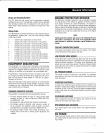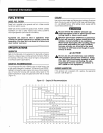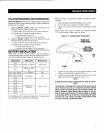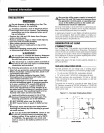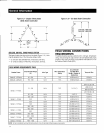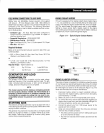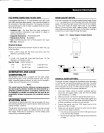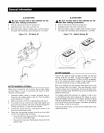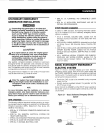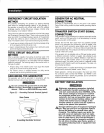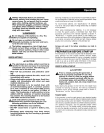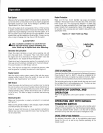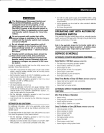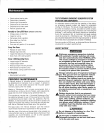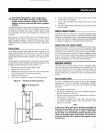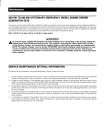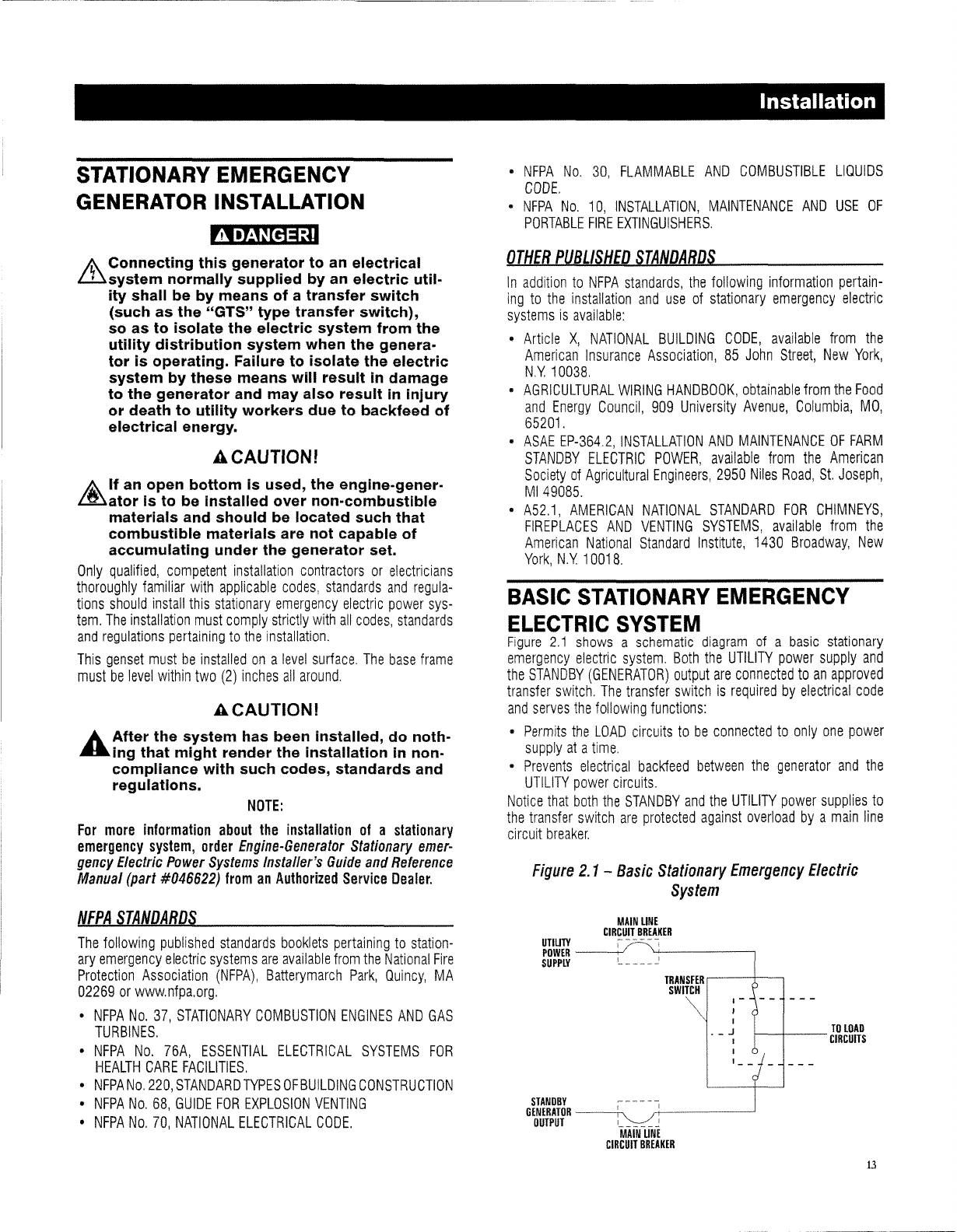
Installation
STATIONARY
EMERGENCY
GENERATOR
INSTALLATION
~
k..
Connecting this generator to an electrical
illsystem
normally supplied by an electric util-
ity shall
be
by means of a transfer switch
(such as the "GTS" type transfer switch),
so as to isolate the electric system from the
utility distribution system when the genera-
tor is operating. Failure to isolate the electric
system by these means will result in damage
to the generator and may also result in injury
or death to utility workers due to backfeed of
electrical energy.
ACAUTIONI
t
If
an open bottom is used, the engine-gener-
Lmator
is to be installed over non-combustible
materials and should be located such that
combustible materials are not capable of
accumulating under the generator set.
Only
qualified,
competent
installation
contractors
or
electricians
thoroughly
familiar
with
applicable
codes,
standards
and
regula-
tions
should
install
this
stationary
emergency
electric
power
sys-
tem.
The
installation
must
comply
strictly
with
all
codes,
standards
and
regulations
pertaining
to
the
installation.
This
genset
must
be
installed
on
a
level
surface.
The
base
frame
must
be
level
within
two
(2)
inches
all
around.
ACAUTIONI
A After the system has been installed, do noth-
.....
ing that might render the installation in non·
compliance with such codes, standards and
regulations.
NOTE:
For
more
information
about
the
installation
of
a
stationary
emergency
system,
order
Engine-Generator
Stationary
emer-
gency
Electric
Power
Systems
Installer's
Guide
and
Reference
Manual
(part
#046622)
from
an
Authorized
Service
Dealer.
•
NFPA
No.
30,
FLAMMABLE
AND
COMBUSTIBLE
LIQUIDS
CODE.
•
NFPA
No.
10,
INSTALLATION,
MAINTENANCE
AND
USE
OF
PORTABLE
FIRE
EXTINGUISHERS.
OTHER
PUBLISHED
STANDARDS
In
addition
to
NFPA
standards,
the
following
information
pertain-
ing
to
the
installation
and
use
of
stationary
emergency
electric
systems
is
available:
•
Article
X,
NATIONAL
BUILDING
CODE,
available
from
the
American
Insurance
Association,
85
John
Street,
New
York,
NY
10038,
o
AGRICULTURAL
WIRING
HANDBOOK,
obtainable
from
the
Food
and
Energy
Council,
909
University
Avenue,
Columbia,
MO,
65201.
•
ASAE
EP-364.2,
INSTALLATION
AND
MAINTENANCE
OF
FARM
STANDBY
ELECTRIC
POWER,
available
from
the
American
Society
of
Agricultural
Engineers,
2950
Niles
Road,
St.
Joseph,
M149085.
•
A52.1,
AMERICAN
NATIONAL
STANDARD
FOR
CHIMNEYS,
FIREPLACES
AND
VENTING
SYSTEMS,
available
from
the
American
National
Standard
Institute,
1430
Broadway,
New
York,
N.Y
10018.
BASIC
STATIONARY
EMERGENCY
ELECTRIC
SYSTEM
Figure
2.1
shows
a
schematic
diagram
of
a
basic
stationary
emergency
electric
system.
Both
the
UTILITY
power
supply
and
the
STANDBY
(GENERATOR)
output
are
connected
to
an
approved
transfer
switch.
The
transfer
switch
is
required
by
electrical
code
and
serves
the
following
functions:
o
Permits
the
LOAD
circuits
to
be
connected
to
only
one
power
supply
at
a
time
.
o
Prevents
electrical
backfeed
between
the
generator
and
the
UTILITY
power
circuits.
Notice
that
both
the
STANDBY
and
the
UTILITY
power
supplies
to
the
transfer
switch
are
protected
against
overload
by
a
main
line
circuit
breaker.
Figure
2.1
-
Basic
Stationary
Emergency
Electric
System
MAIN
UNE
CIRCUIT
BREAKER
TRANSFER
r---+-~
SWITCH
UTIUTY
POWER
--t-/
SUPPLY
'- - - -
--
STANDBY
---
--
GENERATOR
--~'
,..;.-'
--1
OUTPUT
,
~
MAIN
UNE
CIRCUIT
BREAKER
TO
LOAD
c--f---CIRCUITS
I-
I
,
. _ J
,
,
'-
-
NFPA
STANDARDS
The
following
published
standards
booklets
pertaining
to
station-
ary
emergency
electric
systems
are
available
from
the
National
Fire
Protection
Association
(NFPA),
Batterymarch
Park,
Quincy,
MA
02269
or
www.nfpa.org.
o
NFPA
No.
37,
STATIONARY
COMBUSTION
ENGINES
AND
GAS
TURBINES.
o
NFPA
No.
76A,
ESSENTIAL
ELECTRICAL
SYSTEMS
FOR
HEALTH
CARE
FACILITIES.
o
NFPA
No.
220,
STANDARD
TYPES
OF
BUILDING
CONSTRUCTION
o
NFPA
No.
68,
GUIDE
FOR
EXPLOSION
VENTING
o
NFPA
No.
70,
NATIONAL
ELECTRICAL
CODE.
13



